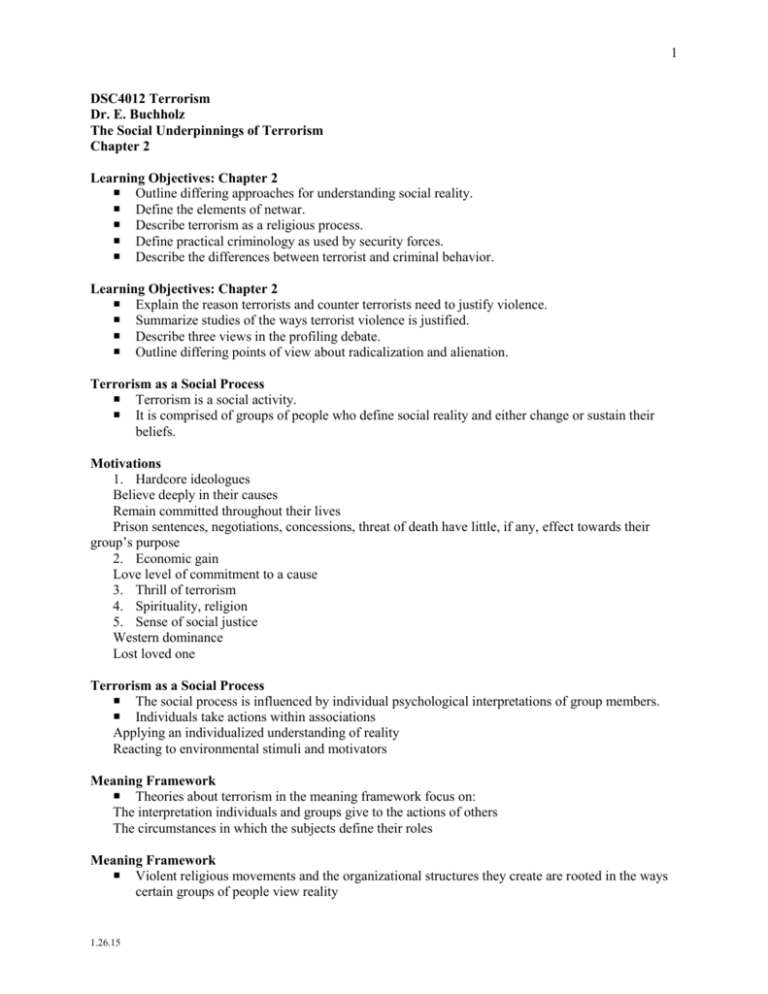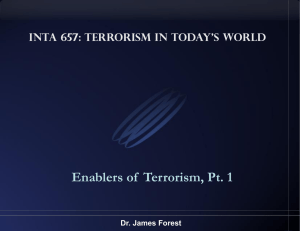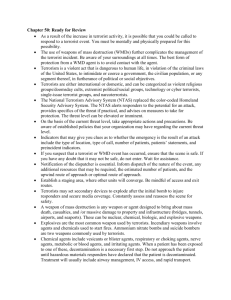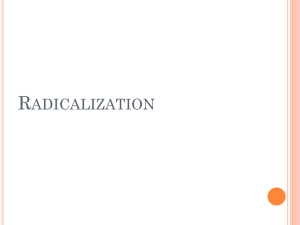Ch. 2
advertisement

1 DSC4012 Terrorism Dr. E. Buchholz The Social Underpinnings of Terrorism Chapter 2 Learning Objectives: Chapter 2 Outline differing approaches for understanding social reality. Define the elements of netwar. Describe terrorism as a religious process. Define practical criminology as used by security forces. Describe the differences between terrorist and criminal behavior. Learning Objectives: Chapter 2 Explain the reason terrorists and counter terrorists need to justify violence. Summarize studies of the ways terrorist violence is justified. Describe three views in the profiling debate. Outline differing points of view about radicalization and alienation. Terrorism as a Social Process Terrorism is a social activity. It is comprised of groups of people who define social reality and either change or sustain their beliefs. Motivations 1. Hardcore ideologues Believe deeply in their causes Remain committed throughout their lives Prison sentences, negotiations, concessions, threat of death have little, if any, effect towards their group’s purpose 2. Economic gain Love level of commitment to a cause 3. Thrill of terrorism 4. Spirituality, religion 5. Sense of social justice Western dominance Lost loved one Terrorism as a Social Process The social process is influenced by individual psychological interpretations of group members. Individuals take actions within associations Applying an individualized understanding of reality Reacting to environmental stimuli and motivators Meaning Framework Theories about terrorism in the meaning framework focus on: The interpretation individuals and groups give to the actions of others The circumstances in which the subjects define their roles Meaning Framework Violent religious movements and the organizational structures they create are rooted in the ways certain groups of people view reality 1.26.15 2 Meaning Framework Terrorist organizations are the result of subjective meanings Any strategy designed to confront and destabilize terrorist organizations must include an aggressive effort to introduce alternative meaning frameworks. Meaning Framework Theory of Action Assumes human beings take action based on the subjective meanings they attribute to social settings. Terrorists take action out of an ideological desire for social change. Tactically Counterterrorism involves taking steps to prevent violence and deconstruct terrorist groups. Strategically Counterterrorism involves countering ideas with alternative interpretations of reality. “Win the hearts and minds…” Structural Framework Another social science tradition seeks to avoid subjective meanings when examining events. Human societies create organizations to accomplish certain required functions. Approaches to understand terrorist behavior by looking at the way organizations function – structural framework. Structural Framework Organizations develop according to the needs of a society or a group of people Such organizations take predictable actions, and serve predictable functions Structure The manner in which a group is organized and its purpose. A groups structure and purpose cause it to act. Structural Framework All groups, including terrorist organizations, take action because they belong to a structure that operates for a specific purpose – social geometry Terrorism develops when a group with inferior power moves against a superior group- usually results in mass civilian casualties Structural Approaches | Netwar There are other structural approaches to terrorism that believe terrorists are united through networks Terrorist organizations are structured in the same manner as communication and transportation systems Structural Approaches | Netwar The traffic pattern on the highway is like a network – the crucial intersections, merge ramps, and expanded traffic lanes are nodes. If vehicles begin clogging at a node, traffic slows or comes to a standstill at many points in the network. Disrupting terrorist networks has the same effect on terrorist operations. Structural Approaches | Netwar Any point where information, weapons, or personnel are gathered or exchanged is called a node The node is the critical target for counterterrorist operations If the node is destroyed, the network is disrupted 1.26.15 3 Anthropological and Sociological Approaches Two primary factors account for the continued influence of religion: First, religion has always been an important influence in the history of humanity. Second, modernization tends to break down communities, families, and social orientation. Terrorism as a Religious Process Strong religious beliefs increase: The likelihood of religious conflict. The intensity of fighting. Violence results when sacred traditions are threatened. Terrorism as a Religious Process Eschatology (theological end of time) Plays a major role Messianic warriors in the end-time correct the heresies of the past and fight for the ideal divine order of a deity. Some empirical findings find that terrorism is partially a religious process. Marvin Harris Two types of religions: Killing and Nonkilling Killing developed during food-gathering cycles of preagrarian and early agricultural societies Premised on a deity helping the community in times of crisis Gods slaughtered enemies Nonkilling embraced enemies and developed elaborate theologies to justify violence as a last resort Often transformed into a militant ideology designed to protect a state or other social group Jessica Stern People are returning to their religious roots as a means to escape the complexity of modern life They seek to ground their lives Old truth in one society may collide with the truths of another society, which often erupts in violence Lone Wolf Religion helps to produce the “lone-wolf avenger” : A person who has a particular ideology but is not part of a group An individual lone-wolf avenger needs to find some type of justification for his or her actions, and religion provides the perfect path Lone Wolf Lone-wolf avengers have a special, narcissistic relationship with their deities. They create a god in their own image. They become the ultimate loners They violently embrace their interpretation of tradition They are the most difficult type of terrorist to deter or detain. Terrorism as a Religious Process Despite utilization of sacred stories and cosmic mythologies, there is a very limited official religious basis for terrorism Religious terrorists are lethal (Berman) Religious terrorist groups killed more people with fewer attacks than secular terrorists Critics cite this includes 9-11 numbers Does not take into consideration government/state terrorism 1.26.15 4 Religious terrorists are deadlier than their secular counterparts. Terrorism as a Religious Process People use stories to explain deep truths beyond the immediate world Terrorist groups build their own mythologies to justify their actions through a story. Stories change the nature of terrorist organizations – they help to produce different group organizations and styles. Criminology Cesar Beccaria (1738-1794) “Father of criminology” Of Crimes and Punishments (1764) Practical criminology focuses on the common actions of lawbreakers Criminology Criminology as applied to terrorism looks at prevention and apprehension Terrorists commit crimes as they struggle for a cause; this sets them apart from ordinary street criminals As first responders, law enforcement personnel must recognize the differences between typical criminal behavior and terrorist activity Criminology Terrorist behavior differs from standard patterns of criminal behavior Terrorists are highly motivated and loyal to a particular cause Terrorists’ ideology is all-consuming Buford Furrow Lone wolf (“berserker”) White supremacist August 10, 1999, Granada Hills, CA, killed a Filipino American postal worker and wounded 5 people at a Jewish Community Center Practical Behavioral Differences Terrorists 1. Focus their actions toward a goal 2. Are dedicated to a cause 3. Rarely cooperate with officials because they do not wish to betray their cause 4. Tend to attack 5. Strike against targets after careful planning 6. Prepare for and rehearse their operations Criminals 1. Are unfocused 2. Are not devoted to crime as a philosophy 3. Will make deals to avoid punishment 4. Usually run when confronted with force 5. Strike when the opportunity to do so is present 6. Rarely train for crime Joint Terrorism Task Forces (JTTFs) Allows the FBI to coordinate law enforcement resources in the face of domestic terrorism and to expand investigations. 1.26.15 5 Focus on ideology, group, and individual behaviors Information sharing over broad geographical Justifying Terrorism Deadly force demands the greatest amount of justification Terrorists have the same need for social approval, but they rarely obtain it because their actions are not sanctioned by the governments they attack Terrorists must look outside normative social channels to gain approval for their acts The terrorist group becomes the primary source of social reality for the individual. It provides social recognition and reinforcement. Justifying Terrorism Borum: No standard rationale for justifying behavior. Reasons for joining Reasons for remaining Reasons for leaving Victoroff: Multiplicity of factors used to justify violence. Post: Us against them mentality. Group and individual acceptance of someone rejected by mainstream society. Group becomes source of social reward due to members’ isolation. Individuals are as much outcasts as the groups they seek to join. The rejection of external authority results in the acceptance of internal authority. Justifying Terrorism In order for social acceptance to be gained, the terrorist group must be isolated from mainstream society. Processes used by American criminal gangs and Arab suicide bombers are the same. Profiling the Terrorist Personality Staub and McCauley believe that certain types of people are drawn toward terrorist groups. McCauley sees four types of personalities: Revolutionaries drawn to a cause People who wander among terrorist groups, People who have a sudden conversion experience People who are attracted by peers Profiling the Terrorist Personality Profiling is a practical criminological process designed to identify the behavioral attributes of certain types of criminals Given the nature of the terrorist, profiling terrorists has sparked heated debate. Researchers argue that the differences in backgrounds and ethnicities prohibit accurate profiles. Profiling the Terrorist Personality Can an accurate profile be made, in your opinion? Borum argues there is no single terrorist personality and that terrorist represent a variety of physical types If terrorist groups become aware that members are being profiled, they select an operative who does not match the profile Jeffrey Ross 1.26.15 6 Ross found 5 interconnected processes involved in terrorism Joining the group Forming the activity Remaining in the campaign Leading the organization Engaging in acts of terrorism Instead of trying to profile the typical terrorist, the social and psychological processes that produce terrorism must be studied. Urban areas produce the greatest potential for unrest and greatest availability of weapons. Jeffrey Ross Structural factors interact with the psychological makeup of potentially violent people to produce terrorism Certain psychological factors interact with social factors to create a climate conducive to terrorism Facilitating traits Fear Anger Depression Guilt Antisocial behavior Strong ego Need for excitement Frustration/narcissism-aggression A person suffers a blow to the ego and reacts hostilely Associational drives A tendency to join groups where benefits are perceived Learning opportunities Teaching terrorism to others Cost-benefit calculations Evaluating whether the cost of an attack is worth the result Path and Routes Horgan believes researchers should search for the “routes to terrorism.” Horgan is concerned with: The person decides to become a terrorist The psychological processes that lead people to terrorist groups. The person decides to remain in a terrorist group. The issues that keep them in the group. Disengagement—the behavior of people who decide to abandon terrorism. Understanding and support for people who want to leave. Radicalization & Alienation As with other areas of terrorism, the areas of radicalization and alienation are fraught with differing views and suggestions for research. Researchers will obtain more fruitful results by examining militant ideology and finding the concepts that are shown to attract followers. 1.26.15 Radicalization 7 The psychological process of adopting extremist positions. Violent radicalization The process of adopting extremist positions and engage in in violence based on a new set of beliefs. Alienation When an individual or group becomes lost in the dominant social world. The person or group is alienated when separated from the dominant values of society at large. Research in Group Processes A number of researchers believe members of terrorist groups go through decision-making processes as they are being radicalized The general knowledge of radicalization is incomplete Radicalization is a process of socialization The result of learning to engage in radicalized violence SAGEMAN’S MODEL Johnny Ryan’s 4 Ps Ryan found four commonalities in groups that move toward violence 1. Persecution A feeling of and/or history of persecution 2. Precedent For resisting the persecutors 3. Piety A righteous or sacred action of devotion 4. Perseverance The ideology has continued over time These four concepts present a single interpretive framework that can be used to understand militant rhetoric and violent behavior. King and Taylor’s 3 models 1. Social and Economic Deprivation Resent resulting from deprived economic circumstances Blaming an outside group for their situation Demonizing the outside group 2. Long-Term Learning Feeling victimized They can never hope to live as well as the group victimizing them Continually seek to understand the reason they are deprived Answers lead to resentment Process is exacerbated when group has religious goals or is seeking religious explanation 3. Psychological Interpretation of Events Gravitate towards others who resent the position of a superior group Develop options to attack what they see as unfair treatment Become morally outrage and develop solidified sense of injustice Take terrorist action Groups in Prison Recent reports suggest that groups are being radicalized in prison. A leader often targets selected prisoners or dominate new inmates using intimidation to force intimidating them until they join the group. 1.26.15 8 Mark Hamm maintains recruitment is similar to procedures used by street gangs. Groups in Prison Three Major Groups Islamic extremism Christian extremists Use selected bible passages White supremacists Norse pantheon of Odin Thor Frida Individual Radicalization Evidence suggests radicalization is not always a group process At the least – it involves individual reflection whether a group plays a role or not. Research indicates individual psychological and sociological factors create the framework for interpreting reality. Post Social structure serves as the major background for interpreting reality. Ideology is transferred from generation to generation with this framework. Traditions of radicalization are passed in this manner. Individual Radicalization Barnett Radicalization tends to happen with individual interpretation of larger actions. The probability of individual radicalization increases when a relatively weak group feels that its existence is threatened and that it has been victimized by a superior power. Feelings increase is the superior groups is believed to be morally depraved. Cases of Radicalization Individual cases in the U.S.: Umar Farouk Abdulmutallab (Lagos, Nigeria) Destroy a Northwest airliner as it entered American airspace. Cases of Radicalization Individual cases in the U.S.: James W. von Brunn Shooting in the U.S. Holocaust Memorial Museum in Washington, D.C. Was waging war on the federal government Loner and white supremacist Hated Jews with a militant passions In 1930s belonged to a German-American friendship group—a front for the Nazi Party Cases of Radicalization Individual cases in the U.S.: Omar Hammami – Muslim father and Christian mother – identity conflict His identity conflict ended when he embraced a violent, intolerant form of Islam to become a commander in Al Shabaab. Commonalities in Radicalization Using previous three individuals – several common forms of behavior. 1.26.15 9 First all three men all came from well-to-do, middle-class environments. The New York Times reports that most international attacks against the U.S. in the 21st Century have come from well-educated terrorists from the middle class. Commonalities in Radicalization Several common forms of behavior (cont) Second, all three men became deeply angered and filled with moral indignation. Alienated from mainstream thought as they expressed anger, and they sought to address their situations by doing something meaningful. Lastly, there was some type of event that triggered their final decision to take violent action. Religious Radicalization Adopt rigid, literalist interpretations of religion Only trust selected radical sources of theological information Do not tolerate deviance from their interpretation Religious Radicalization “Clash of Civilizations” The West is at war with Islam Selectively interpret government actions to prove the point Aggressively and vehemently attempt to convert other Muslims to their point of view Publicly denounce those who will not follow them Break away from mainstream mosques or join an organization that supports their interpretation of religion Begin to adopt traditional forms of dress Religious Radicalization Berman The number of terrorist groups is small, while the number of radicalized people is very large. The key to counterterrorism is to focus on radicalized individuals when they try to join the militant group. Horgan suggests it’s important to know how to extricate people. Research Criticized The idea that research in radicalization and alienation will produce valuable knowledge is debated. No general consensus about the definition of radicalization. Term is utilized in a variety of different contexts. Suggested that more beneficial results would be gained through the examination of militant ideology and concepts that attract followers. Research Criticized Bhart says radicalization is associated with alienation. Western governments seek to integrate and assimilate immigrant populations This poses a problem as many immigrants choose to maintain their native identity Political and religious affiliations Purposeful rejection of Western norms Chapter Take-Aways Terrorism is a social process that can be studied with the same methods used by social scientists. One method is to search for meanings behind actions. The second method used to analyze terrorism is to look for structures. Social geometry shows movement within structures. The netwar metaphor represents a practical application of this technique. 1.26.15 10 Researchers who believe that modern terrorism has been changed by religion look for meanings that drive actions. Chapter Take-Aways Security forces search for practical behavior clues that can be used against terrorists. Researchers search for the ways in which terrorist behavior differs from normal criminals. They seek an understanding of the ways terrorists justify violence. Some researchers have tried to model terrorism by profiling terrorists or looking for models of radicalization and alienation. 1.26.15









